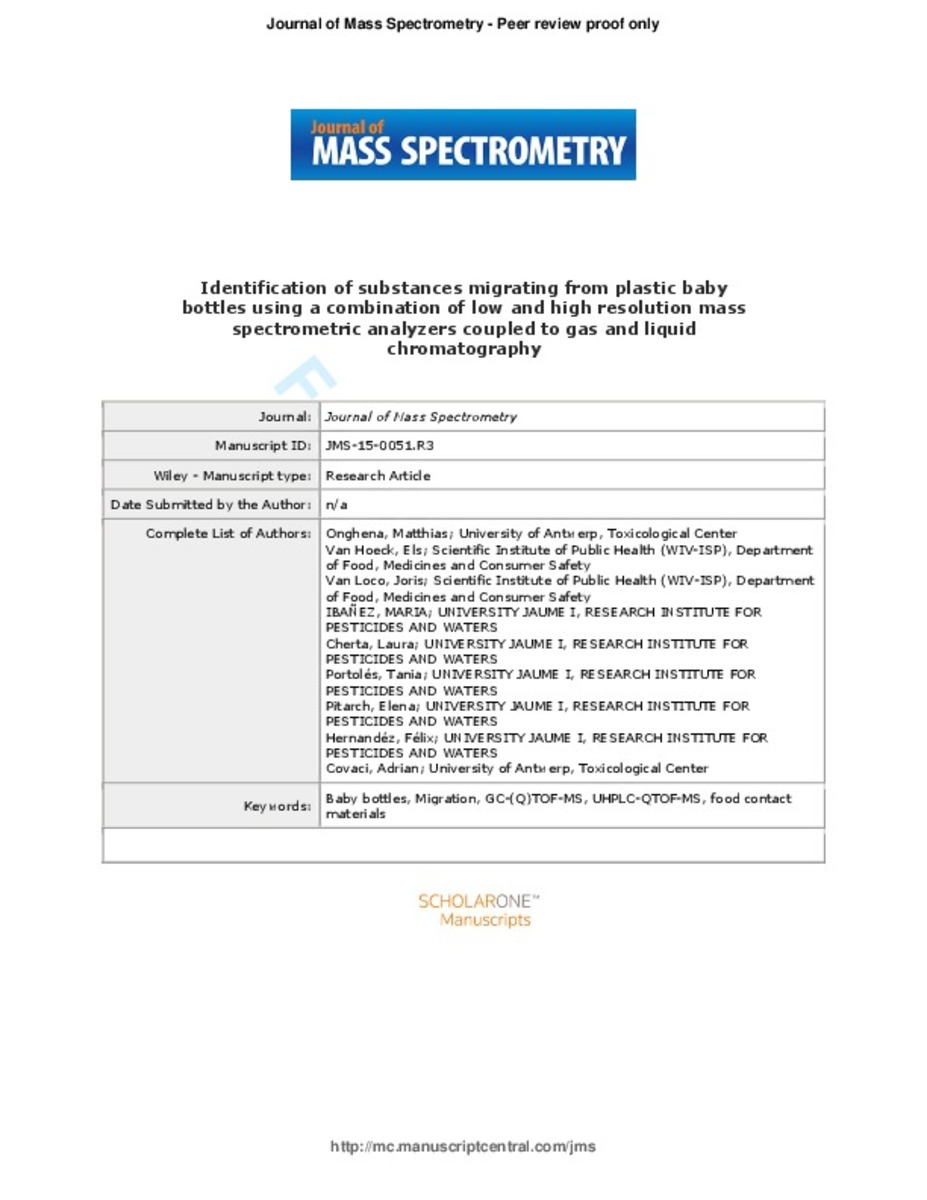Mostrar el registro sencillo del ítem
Identification of substances migrating from plastic baby bottles using a combination of low-resolution and high-resolution mass spectrometric analysers coupled to gas and liquid chromatography
| dc.contributor.author | Onghena, Matthias | |
| dc.contributor.author | Van Hoeck, Els | |
| dc.contributor.author | Van Loco, Joris | |
| dc.contributor.author | Ibáñez, Maria | |
| dc.contributor.author | Cherta Cucala, Laura | |
| dc.contributor.author | Portoles, Tania | |
| dc.contributor.author | Pitarch, Elena | |
| dc.contributor.author | Hernandez, Felix | |
| dc.contributor.author | Lemière, Filip | |
| dc.contributor.author | Covaci, Adrian | |
| dc.date.accessioned | 2015-11-25T10:54:11Z | |
| dc.date.available | 2015-11-25T10:54:11Z | |
| dc.date.issued | 2015 | |
| dc.identifier.issn | 1076-5174 | |
| dc.identifier.issn | 1096-9888 | |
| dc.identifier.uri | http://hdl.handle.net/10234/141285 | |
| dc.description.abstract | This work presents a strategy for elucidation of unknown migrants from plastic food contact materials (baby bottles) using a combination of analytical techniques in an untargeted approach. First, gas chromatography (GC) coupled to mass spectrometry (MS) in electron ionisation mode was used to identify migrants through spectral library matching. When no acceptable match was obtained, a second analysis by GC-(electron ionisation) high resolution mass spectrometry time of flight (TOF) was applied to obtain accurate mass fragmentation spectra and isotopic patterns. Databases were then searched to find a possible elemental composition for the unknown compounds. Finally, a GC hybrid quadrupole-TOF-MS with an atmospheric pressure chemical ionisation source was used to obtain the molecular ion or the protonated molecule. Accurate mass data also provided additional information on the fragmentation behaviour as two acquisition functions with different collision energies were available (MSE approach). In the low-energy function, limited fragmentation took place, whereas for the high-energy function, fragmentation was enhanced. For less volatile unknowns, ultra-high pressure liquid chromatography-quadrupole-TOF-MS was additionally applied. Using a home-made database containing common migrating compounds and plastic additives, tentative identification was made for several positive findings based on accurate mass of the (de)protonated molecule, product ion fragments and characteristic isotopic ions. Six illustrative examples are shown to demonstrate the modus operandi and the difficulties encountered during identification. The combination of these techniques was proven to be a powerful tool for the elucidation of unknown migrating compounds from plastic baby bottles. | ca_CA |
| dc.description.sponsorShip | Federal Government Service for Public Health of Belgium through project: ALTPOLYCARB Generalitat Valenciana (Group of Excellence Prometeo) II/2014/023 ; ISIC/2012/016 Envi-Food | |
| dc.format.mimetype | application/pdf | ca_CA |
| dc.language.iso | eng | ca_CA |
| dc.publisher | WILEY-BLACKWELL | ca_CA |
| dc.relation.isPartOf | Journal of Mass Spectrometry, Vol.50, Is.11 (november 2015) | ca_CA |
| dc.rights.uri | http://rightsstatements.org/vocab/CNE/1.0/ | * |
| dc.subject | baby bottles | ca_CA |
| dc.subject | migration | ca_CA |
| dc.subject | GC-(Q)TOF-MS | ca_CA |
| dc.subject | UHPLC-QTOF-MS | ca_CA |
| dc.subject | food contact materials | ca_CA |
| dc.title | Identification of substances migrating from plastic baby bottles using a combination of low-resolution and high-resolution mass spectrometric analysers coupled to gas and liquid chromatography | ca_CA |
| dc.type | info:eu-repo/semantics/article | ca_CA |
| dc.identifier.doi | http://dx.doi.org/10.1002/jms.3644 | |
| dc.rights.accessRights | info:eu-repo/semantics/openAccess | ca_CA |
| dc.type.version | info:eu-repo/semantics/submittedVersion |
Ficheros en el ítem
Este ítem aparece en la(s) siguiente(s) colección(ones)
-
IUPA_Articles [306]







